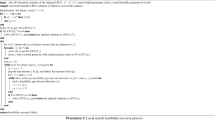Abstract
In recent years the lift-and-project approach has been used successfully within a branch-and-cut framework to solve large, difficult pure and mixed 0–1 programs that have resisted solution efforts by pure branch and bound codes. The approach uses a linear description in a higher dimensional space of the convex hull of the disjunctive set created by imposing one or several 0–1 conditions. By solving a linear program derived from this higher dimensional representation — the cut generating linear program (CGLP) — the standard lift-and-project procedure obtains a deepest cut in a well defined sense. We propose a modification of CGLP that allows us to generate not just one deepest cut, but a class of cuts with desirable properties, each at the cost of one extra pivot in the optimal tableau of the modified CGLP.
Similar content being viewed by others
References
E. Balas, Disjunctive programming: Properties of the convex hull of feasible points, MSRR #348, Carnegie Mellon University, July 1974.
E. Balas, Disjunctive programming,Annals of Discrete Mathematics 5 (1979) 3–51.
E. Balas, Disjunctive programming and a hierarchy of relaxations for discrete optimization problems,SIAM Journal on Algebraic and Discrete Methods 6 (1985) 466–485.
E. Balas, Enhancements of lift-and-project, GSIA, Carnegie Mellon University, January 1996.
E. Balas, S. Ceria and G. Cornuéjols, A lift-and-project cutting plane algorithm for mixed 0–1 programs,Mathematical Programming 58 (1993) 295–324.
E. Balas, S. Ceria and G. Cornuéjols, Mixed 0–1 programming by lift-and-project in a branch-and-cut framework,Management Science 42 (1996) 1229–1246.
E. Balas, S. Ceria, G. Cornuéjols and G. Pataki, Polyhedral methods for the maximum clique problem, in: D. Johnson and M. Trick, eds.,Clique, Coloring and Satisfiability: The Second DIMACS Challenge (The American Mathematical Society, Providence, RI, 1996), 11–27.
R. Bixby, W. Cook, A. Cox and E. Lee, Computational experience with parallel mixed integer programming in a distributed environment, Rice University, June 1995, revised December 1996.
S. Ceria, Lift-and-project methods for mixed 0–1 programs, Ph.D. Dissertation, GSIA, Carnegie Mellon University, 1993.
S. Ceria and J. Soares, Convex programming for disjunctive optimization, G.S.B., Columbia University, November 1996.
L. Lovász and A. Schrijver, Cones of matrices and set functions and 0–1 optimization,SIAM Journal on Optimization 1 (1991) 166–190.
H. Sherali and W. Adams, A hierarchy of relaxations between the continuous and convex hull representations for zero-one programming problems,SIAM Journal on Discrete Mathematics 3 (1990) 411–430.
R.A. Stubbs and S. Mehrotra, A branch-and-cut method for 0–1 mixed convex programming, Dept. of IE, Northwestern University, Technical Report 96-01, January 1996.
S. Thienel, ABACUS: A Branch and Cut System, Doctoral Dissertation, Faculty of Mathematics and the Natural Sciences, University of Köln, 1995.
Author information
Authors and Affiliations
Additional information
This research was supported by the National Science Foundation through grants DMI-9424348 and DMS-9509581 and the Office of Naval Research through Contract N00014-89-J-1063.
Rights and permissions
About this article
Cite this article
Balas, E. A modified lift-and-project procedure. Mathematical Programming 79, 19–31 (1997). https://doi.org/10.1007/BF02614309
Received:
Accepted:
Issue Date:
DOI: https://doi.org/10.1007/BF02614309




